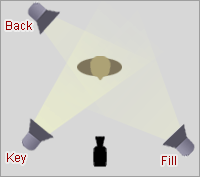- High key lighting - indicates a bight lit scene with a few shadows; usually provided by one source of light.
- Low key lighting - is where the lighting s more towards the greyer and darker scale, where there is a good deal of shadow ad where the key light is less bright and does not dominate.
- High contrast lighting - is where there is a strong contrast between bright light and shadow, with a small amount of in between grey scale.
- Hard light clearly illuminates areas, sharply outlines and illuminates characters, brings out detail and texture and markedly separates light and shadows. hard light gives a hard, crisp, sharply defined appearance, and casts a sharp, clearly defined shadow
- Soft light covers a wider area with a more diffuse light, diminishes outline and clarity of characters, minimises shadows and reduces modelling of details and texture; soft light tends to hide surface irregularities and detail.
Spun glass diffusers are used over the front of studio lights to soften and diffuse their beams and to reduce the intensity of the light.
Three point lighting is the standard method used in visual media such as film, still photography and computer generated imagery.
1. Key light
This is the main light.
It is usually the strongest and has the most influence of the look of the scene.
The key light is placed to one side of the camera/subject so that this side is well lit and the other has some shadow.
It provides hard light, like that from the sun on a clear day: a bright light with hard edged shadows.
It provides excellent modelling by highlighting the shape and contour of the subject.
This is the secondary light and is placed on the opposite side tot eh key light.
Its light can be likened to indirect sunlight or reflected light from the environment.
It is used to fill the shadows created by the key. The fill will usually be softer and less bright than the key and casts soft indistinct shadows.
It is sometimes referred to as the highlight as it is often used to give a sheen or highlight to an actor's hair
3. Back light
The back light is placed behind the subject and lights it from the rear.
Rather than providing direct lighting (which the key and the fill give), its purpose is purely for modelling - to provide definition and subtle highlights around the subjects outline.
This helps separate the subject from the background and give a three dimensional look.


No comments:
Post a Comment